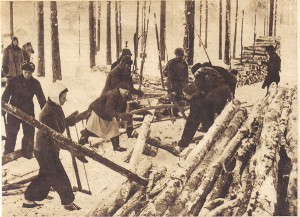 Dr Tuomas Tepora is a visiting postdoctoral fellow at the Centre for the History of the Emotions at Queen Mary during the academic year 2012–13 and holds a postdoctoral position at the University of Helsinki. His research deals with emotions and the cultural history of war in Finland in the early 20th century. His particular interest is the concept of sacrifice in a modern framework. This includes the various notions, symbols and memories of modern war-related sacrifice and also the psychology behind the feelings and experiences of sacrifice, self-sacrifice and victimisation. His current project includes a wide array of collective emotions experienced in a society at war. These include love, attachment and hate; trust and uncertainty; collective honour and shame; public calls for chastity and experiences of social decadence. Tuomas is also interested in new research within the field of critical neuroscience. In this post for the History of Emotions blog, he explores the history of the distinctively Finnish quality of ‘sisu’.
Dr Tuomas Tepora is a visiting postdoctoral fellow at the Centre for the History of the Emotions at Queen Mary during the academic year 2012–13 and holds a postdoctoral position at the University of Helsinki. His research deals with emotions and the cultural history of war in Finland in the early 20th century. His particular interest is the concept of sacrifice in a modern framework. This includes the various notions, symbols and memories of modern war-related sacrifice and also the psychology behind the feelings and experiences of sacrifice, self-sacrifice and victimisation. His current project includes a wide array of collective emotions experienced in a society at war. These include love, attachment and hate; trust and uncertainty; collective honour and shame; public calls for chastity and experiences of social decadence. Tuomas is also interested in new research within the field of critical neuroscience. In this post for the History of Emotions blog, he explores the history of the distinctively Finnish quality of ‘sisu’.
A fascinating series on the emotional history of Britain was recently broadcast on BBC Two, entitled Ian Hislop’s Stiff Upper Lip (the subject of several earlier posts on this blog). In line with a Western trend of moving away from emotional restraint, we learned that the stiff upper lip isn’t perhaps considered the most valued British quality today. Nor, in earlier periods, was it the most prevalent emotional style. In fact, the era of the stiff upper lip in Britain coincided with certain changes in society in the late 19th and early 20th centuries. Nevertheless, it seems that the ‘stiff upper lip’ still hasn’t gone away for good. The concept and the idea live on as a widely recognised symbol of Britishness, and as a repository of cultural meaning.
For someone like me who did not grow up in Britain and who thus has not been emotionally trained to keep a stiff upper lip, keep calm and carry on, the series was perhaps even more illuminating. In my native Finland a comparable national characteristic is familiar, although it has evolved in a quite different environment and from different historical experiences. There is a famous word for this quality: “sisu”. And, as with the concept of the stiff upper lip, sisu has a history of shifting meanings and its cultural, social and political significance has seen highs and lows. Sisu certainly represents a national symbol in Finland and like all national symbols, it is contested and debated, celebrated and scorned.
Sisu translates as “having guts”. Etymologically the word means quite literally the insides (of a person) or interior. What does sisu denote, then, and how and when did it become such a powerful concept?

A painting by Eero Järnefelt from 1893,entitled “Burning the Brushwood”
(or, in Finnish something more like “plodders under material pressure”), capturing the grim and harsh yet idealized Finnish national spirit of the nineteenth century.
The dictionary definition of sisu tells us that it has to do with perseverance and resoluteness. As a quality of a person it signifies long lasting and silent courage in the face of every possible obstacle and overcoming even repeated failures. Having sisu does not just imply heroism under pressure, but also composure in the midst of joyful celebrations; perhaps something similar to the spirit of Rudyard Kipling’s famous couplet:
If you can meet with Triumph and Disaster
And treat those two impostors just the same…
Sisu denotes also the acceptance of a usually grim reality without complaint but it doesn’t mean submission to it. On the contrary, a person with sisu calmly but sturdily navigates him or herself in the midst of life’s difficulties. If one overcomes them, he or she takes the victory without making too much noise about it. If one fails, things go on as usual. Sisu may in some rare occasions refer to noble and gentlemanly attitudes but it’s more commonly understood in relation to rough and physical labour, bushwhacking and breaking new ground.
In other words, the sisu denotes something of a stereotypical concept of Finnishness. This stereotype is well propagated and recreated by Finns themselves who always feel free to tell foreigners about their sisu. Sisu has thus been coined as a collective quality of a small northern nation who has been forced to endure harsh climate and hostile neighbours. As it is, sisu has very positive connotations for people but historically, this was not always the case. Finns might brag about their sisu for foreigners and celebrate it as a r national quality but when it comes to acknowledging fellow Finns’ sisu the word may lend itself to rather malevolent connotations.
Looking at the history of the word tells us why. The first literary remarks on sisu date from the 16th century. The Finnish written language had only recently been developed for religious purposes after the Reformation. According to Maija Länsimäki at first sisu referred only to a temper of any kind, but in the hands of Lutheran clergy the word quickly developed to mean “bad”. “Having sisu” further denoted a tendency of behaving badly. The word derived straight from the person’s insides, intestines (sisucunda). In fact in 1745 Daniel Juslenius defined “sisucunda” in his dictionary as the location in human body where strong affects originated. It seems that until the end of the 19th century the word had rather negative meaning in literature and, moreover, it implied strong and disturbing emotions and feelings, which weren’t kept at check. This definition seems to be quite the opposite from the definition of the positively valued perseverance and courage the concept denotes at present, although we cannot know for sure how the people outside the literati felt sisu before the late 19th century.
But even today the word sisu is a double-edged sword. As a quality of one’s own it may be celebrated but at the same time as another person’s quality it may have dubious qualities. Terms like “sisupussi” (shrew; fighter) and “pahansisuinen” (bad-tempered) imply that having sisu is something which requires strong emotional navigation. Sisu must be tamed and directed to productive behaviour. The same source which gives rise to outbursts of disturbing and defiant behaviour is also the source of determination and equanimity. Interestingly, it may well be the defiance sisu denotes that made it so popular a concept and a symbol of Finnishness in the early 20th century and at the same time transformed the word’s connotation into a positive one.
Sisu was in high fashion in the 1920s and 30s. The newly independent nation celebrated its sovereignty by consciously looking for and reinventing its roots. The national romantic nation-building efforts begun in the late 19th century with the “invention” of national costumes and heroic history echoed in establishing sisu as something uniquely Finnish. The sports and sisu became close acquaintances testifying of Finnish endurance and determination in the international arena. The word came to denote a national character apart from its simple meaning of certain kind of temper. Sisu’s older connotation of ill-temperedness was transformed into virtue. The resolute defiance in the face of external hardships became a hoped for quality in the individual and the nation as a whole. This is the period when the modern definition of sisu originated.
During the Second World War sisu experienced an elevation to an almost sacred status. Interestingly the authorities didn’t explicitly use it so much in internal propaganda but as a showpiece for foreign reporters. One of the earliest depictions of sisu in English can be traced to that period. The Winter War (1939–40) in fact made sisu somewhat famous in the English-speaking world. The international press portrayed Finland’s battle against the powerful enemy as a display of that peculiar sense of perseverance. The following excerpt from Time Magazine is illuminating (and tells a lot about the American way of seeing the gutful emotion, too):
The Finns have something they call sisu. It is a compound of bravado and bravery, of ferocity and tenacity, of the ability to keep fighting after most people would have quit, and to fight with the will to win. The Finns translate sisu as “the Finnish spirit” but it is a much more gutful word than that. Last week the Finns gave the world a good example of sisu by carrying the war into Russian territory on one front while on another they withstood merciless attacks by a reinforced Russian Army.
(Time Magazine, January 8, 1940, retrieved from Time Magazine Archives)
The Reader’s Digest, in turn, titled its report on the war in March 1940 as “Sisu: A Word That Explains Finland”. The Finnish government played a major role in propagating sisu for foreign reporters. It was in fact something the foreign liaisons officers were instructed to tell to their foreign contacts. In terms of promoting the term, the propaganda proved successful. The foreign reporters bought it and sisu briefly gathered the world’s attention and added to the mythical status of the word in describing the Finnish character.
The emotional reality of the war was, inevitably, much more nuanced than the “bravado and bravery” of sisu. Finland was defeated and the result lead to a new, longer and bloodier conflict called the Continuation War (1941–44), which was part of the German offensive to the Soviet Union. Perhaps sisu helped to overcome the defeats, traumas and other spoils of the war or at least it acted as a cultural reservoir of meaning in the times of crises. Nevertheless, when talking about war, it always seems a little banal to explain survival and recovery from the hardships with concepts like sisu or the ‘stiff upper lip’. Sometimes fortunately, other times less so, not every emotion was held in check.
As with the ‘stiff upper lip’, the post-Second World War decades saw the gradual decline of the lure of sisu. The expression of one’s feelings has become much more desirable in the last few decades, therapy culture flourishes, and with Finland eagerly integrating to Europe since the constraints set by the Cold War vanished, the national chararacteristics have perhaps been downplayed in public discourses and values in favour of some, quite obscure “European values”. Although the concept experienced a brief renaissance in the early 1990s along with neo-patriotism following the collapse of the Soviet Union (see for instance the book Suomalainen sisu, The Finnish Sisu, from 1994, a collection of essays portraying chapters in Finnish history as manifestations of sisu!), the word has also become to denote a set of emotions appropriate for local patriots or provincialists. Sisu’s status as a national symbol has also sparked contest over its appropriate use. For instance with right-wing populism on the rise all over Europe, one of the Finnish right-wing associations adopted the name Suomen Sisu (The Finnish Sisu) in 1998 and has acted against multiculturalism and immigration. Four members of the association are members of parliament at the moment. Whereas sisu’s popularity isn’t perhaps in its highest at the moment in Finland, expat Finns seem to enjoy the concept. The state-sponsored radio station in Sweden serving the large Finnish population in the country is called Sisu Radio and there are Sisu media elsewhere, too.
The story of sisu isn’t complete without perhaps its most intriguing features. What seems to be the most remarkable and quite unique quality in the concept is its commercial value from early on. Two brands were initiated during the heyday of sisu and nationalism in the interwar period: Sisu pastilles (established in 1928) and Sisu trucks (established in 1931, later also military vehicles under the same brand). Both brands are still going strong. Sisu pastilles, which are sort of throat lozenges, had gained a huge popularity already by the 1930s and the brand has retained its desirability. Its popularity tells us also that the word is not entirely lost for political extremism.
The Sisu trademark has effectively utilised the classic qualities of the emotional concept in its advertising. I think it’s a good way to finish this entry by posting a link to the classic Sisu pastilles advert from 1975. The ad can be watched as an exercise in self-irony, but admittedly seeing this it isn’t perhaps so difficult to see why some people might want to distance themselves from the things sisu represents. The line “Alussa olivat suo, kuokka ja Jussi” in the advert refers to the beginning of the trilogy Under the North Star (1959–1962) by Väinö Linna, and reads “In the beginning there was the marsh, the hoe, and Jussi”. The reference is obviously to the biblical creation story, but it implies that the Finnish way of beginning didn’t exactly include the Word. The beginning included sisu, though, and the ad ends with a line “Finnish Sisu since 1928”.





Thanks, really enjoyed this.
Thank you! Wonderful piece.
Pingback: Now We Are Two | The History of Emotions Blog
Hei Tuomas, suuri kiitos upeasta ja yksityiskohtaisesta artikkelistasi. Teen tutkimusta sisusta psykologisena voimavarana ja sain tästä hulppeaa substanssia muutamia historia-aukkoja paikkaamaan. Kaunista työtä. Love it!
Lämpimin terveisin,
Emilia
I enjoyed your article for several reasons. All of my paternal grandparents were Finns and my father, born 1930 in Minnesota, did not learn English until he went to school. He often told me that my temperament was that of a typical Finn: that I had Sisu in my blood. Along with the characteristics you mentioned above, Dad explained the quiet nature of Sisu, with one’s feelings unshared and remaining as an interior life- force. I found your definition of Sisu as “composure in the midst of joyful celebration” to be true of my elder Finn relatives. Dad also gave me his take on emotional extremes: Avoid them, for one will–like a seesaw–surely be followed by it opposite.